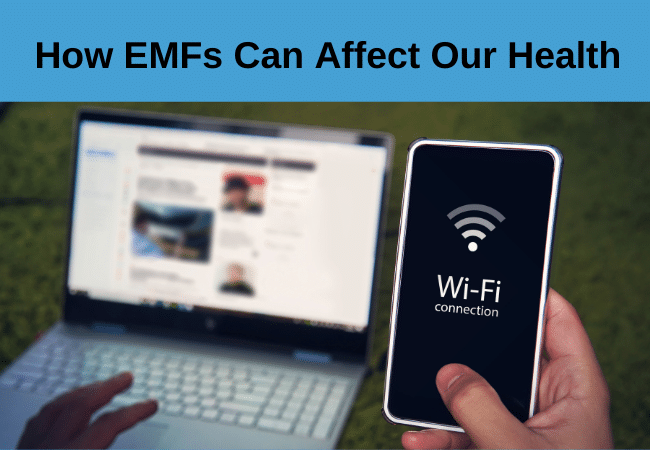Every day, we are bombarded by a toxic smog of EMFs (electric magnetic fields), disguised as modern day conveniences—WiFi, our wireless devices, household appliances—that we cannot imagine living without!
In order to understand how overexposure to EMFs can adversely affect our health, it is important to understand what EMFs are.
What are EMFs?
EMF stands for Electromagnetic Fields.
According to the National Institute of Environmental Health Sciences (NIEHS), EMFs are “invisible areas of energy, often referred to as radiation, that are associated with the use of electrical power and various forms of natural and man-made lighting.1
A natural source of radiation is the sun, which consists of electromagnetic waves, ranging from infrared (IR) to ultraviolet rays (UV). It also includes visible light, which is between IR and UV on the electromagnetic spectrum.2
With the introduction of the light bulb in the 19th century, however, man-made sources of EMFs that relied on electricity (and electric power lines) increased exponentially over the next 150 years, ranging from household appliances, to medical imaging procedures, like MRIs and X-rays.
Today, in the 21st century, we are now exposed to a lot more EMF radiation from man-made sources—at levels some experts estimate to be 10 billion times higher than the 1960s.3
The National Institute of Environmental Health Sciences categorizes EMFs in two groups:
- Non-ionizing.Emitting low levels of radiation, these include: microwave ovens, cell phones, Wi-Fi routers, cell towers, tablets, laptops, baby monitors, smart meters, smart TVs, Bluetooth devices, power lines and MRIs.4, 5
- Ionizing.Emitting mid- to high-frequency radiation that can lead to cellular and/or DNA damage, these include: UV rays (think tanning beds!), diagnostic medical X-rays (including dental X-rays) and Gamma rays.6 Radon gas is a natural source of ionizing radiation.7
How EMFs Affect the Body
The human body is actually a complex electromagnetic system. Our cells conduct electrical currents that our body uses; for example, the nervous system requires electricity to send signals throughout the body and to the brain that enable us to move, think and feel. Magnetic fields have also been detected from the human heart and brain. 8
Cumulative EMF exposure from all sources can significantly reduce melatonin, interfering with our sleep—and our overall health. 9 In fact, the International Agency for Research on Cancer classifies electromagnetic fields (EMFs) as “possibly carcinogenic” to humans, with the potential to transform normal cells into cancer cells.10, 11
The problem, however, is that because the electromagnetic signals of the human body are very weak, chronic exposure to man-made EMFs (like WiFi, Bluetooth and cell phones) can disrupt the intricate but delicate electromagnetic systems of the body, in particular, for the heart, brain and mitochondria (the “powerhouses of the cell”).
People who are very sensitive to EMFs may develop electromagnetic hypersensitivity (EMHS), a condition not yet recognized by the conventional medical community. Those who are electrosensitive may experience a constellation of physical, emotional and neurological symptoms, including sleep disturbance (insomnia or problems staying asleep) and fatigue, as well as chronic inflammatory disorders.12
Chronic exposure to EMFs can result in:13, 14
- Fatigue / weakness
- Sleep disturbances, including insomnia
- Headaches / migraines
- Brain fog / difficulty concentrating
- Depression / anxiety
- Memory problems
- Visual disruptions / light sensitivity
- Skin problems
- Heart palpitations
- Dizziness
- Oxidative stress
- Inflammation
- Hormone imbalances
- Increased risk of cancer
Ways to reduce your EMF exposure:
Limit the time you spend gazing at your computer, tablet or phone to protect yourself from the cumulative damage of invisible electrical currents.
Do NOT sleep with your phone under your pillow! (I can’t tell you how many people do this!) If you use your phone as an alarm, switch to “Airplane” mode and place phone in another room.
Keep all of your wireless devices, including your phone, at least one foot away from your body.
Completely turn off all electronic devices (e.g., phone, tablet or computer); or, at a minimum, switch to “Airplane” mode and/or turn off the Wi-Fi function before bed.
Instead of a wireless and/or Bluetooth connection, opt for a hardwired ethernet cable connection to your computer, laptop and/or tablet.
If you have a WiFi router in your home, turn it off at night.
If you need to charge any wireless electronic devices during the night, make sure the device(s) are turned off or in “Airplane” mode—and keep as far away from the bedroom as possible.
Trade your digital clock, which runs on electricity, for a battery-operated alarm clock.
Just say “no” to a smart meter at your home; or if you have one, talk to the utility company about replacing it with an analog meter.


